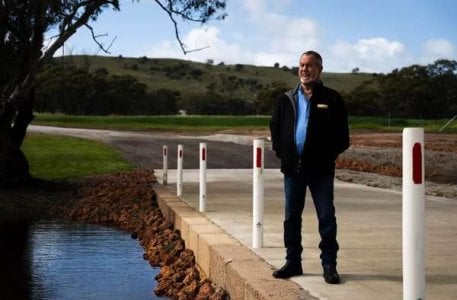Man faces thousands of fines after building bridges on his property. Why?
By
Danielle F.
- Replies 46
In the picturesque landscape of Toodyay, 85 km northwest of Perth, a man's attempt to restore access to his property led to a costly legal battle.
This man's experience should be a stark reminder of the importance of cultural heritage laws in the country.
Property owner Tony Maddox found himself in deep waters after reconstructing a bridge over a creek on his 14-acre estate.
Tony initially saw the bridge as a necessity so he could enter his home.
His home's original crossing was heavily damaged by floods, which prompted the construction of the bridge.
Maddox built a concrete bridge and removed silt from the creek.
Unbeknownst to Maddox, the act inadvertently breached the Aboriginal Heritage Act 2006.
The act disturbed a site of significant cultural importance to the Noongar people—the Waugul, a 'mythical rainbow serpent'.
The Department of Planning, Lands and Heritage took the matter seriously, as they charged Mr Maddox.
Under the said legislation, Aboriginal heritage sites are protected from excavation, destruction, concealment, or alteration without proper approval.
The potential penalties for Mr Maddox's action included up to nine months in jail and a $20,000 fine.
Fortunately, the Perth Magistrates Court handed down a more lenient sentence—a $2,000 fine, a spent conviction, and $5,000 in costs.
Magistrate Andrew Matthews emphasised that while the damage was not significant, the site had been altered.
Prosecutor Lorraine Allen also echoed the sentiment and hoped that Mr Maddox's case could serve as a deterrent against the destruction or alteration of Aboriginal heritage.
Despite the reduced sentence, it took an emotional and financial toll on Mr Maddox.
'I literally haven't worked all year; I've been fighting this for a year. This destroys your heart. Destroys your head, destroys your soul,' Mr Maddox shared in an interview.
'And what is the outcome? The outcome is going to be an awful lot of money piling up. For what?'
'There is nothing in the Act that tells them they have the power to ask me to remove the crossing,' he further lamented.
Learn more about Tony Maddox's experience in this video:
Source: Sky News Australia/Facebook
Tony Maddox's story should be a cautionary tale for all Australians about awareness and respect towards cultural heritage laws.
It highlighted the need for due diligence and seeking appropriate approvals when undertaking any work that may impact heritage sites.
For our readers, particularly those who own property or are considering development, this incident underscored the necessity of familiarising heritage legislation.
It's not just about compliance; it's about respect for the rich cultural history that predates modern development.

Have you ever encountered similar issues on your property? How can we better balance property management with the protection of cultural heritage? Please share your thoughts about this matter in the comments section below.
This man's experience should be a stark reminder of the importance of cultural heritage laws in the country.
Property owner Tony Maddox found himself in deep waters after reconstructing a bridge over a creek on his 14-acre estate.
Tony initially saw the bridge as a necessity so he could enter his home.
His home's original crossing was heavily damaged by floods, which prompted the construction of the bridge.
Maddox built a concrete bridge and removed silt from the creek.
Unbeknownst to Maddox, the act inadvertently breached the Aboriginal Heritage Act 2006.
The act disturbed a site of significant cultural importance to the Noongar people—the Waugul, a 'mythical rainbow serpent'.
The Department of Planning, Lands and Heritage took the matter seriously, as they charged Mr Maddox.
Under the said legislation, Aboriginal heritage sites are protected from excavation, destruction, concealment, or alteration without proper approval.
The potential penalties for Mr Maddox's action included up to nine months in jail and a $20,000 fine.
Fortunately, the Perth Magistrates Court handed down a more lenient sentence—a $2,000 fine, a spent conviction, and $5,000 in costs.
Magistrate Andrew Matthews emphasised that while the damage was not significant, the site had been altered.
Prosecutor Lorraine Allen also echoed the sentiment and hoped that Mr Maddox's case could serve as a deterrent against the destruction or alteration of Aboriginal heritage.
Despite the reduced sentence, it took an emotional and financial toll on Mr Maddox.
'I literally haven't worked all year; I've been fighting this for a year. This destroys your heart. Destroys your head, destroys your soul,' Mr Maddox shared in an interview.
'And what is the outcome? The outcome is going to be an awful lot of money piling up. For what?'
'There is nothing in the Act that tells them they have the power to ask me to remove the crossing,' he further lamented.
Learn more about Tony Maddox's experience in this video:
Source: Sky News Australia/Facebook
Tony Maddox's story should be a cautionary tale for all Australians about awareness and respect towards cultural heritage laws.
It highlighted the need for due diligence and seeking appropriate approvals when undertaking any work that may impact heritage sites.
For our readers, particularly those who own property or are considering development, this incident underscored the necessity of familiarising heritage legislation.
It's not just about compliance; it's about respect for the rich cultural history that predates modern development.
Key Takeaways
- A Toodyay man has been fined for inadvertently breaching the Aboriginal Heritage Act by building a bridge on his property.
- The bridge's construction disturbed an Aboriginal sacred site associated with the Rainbow Serpent, a central figure in Noongar mythology.
- Although the bridge did not cause significant physical damage, the court ruled that the site had been altered.
- The property owner stated that the legal battle took a significant mental and financial toll on him.








